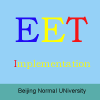-
Concept Maps for Science
普通类 -
- 支持
- 批判
- 提问
- 解释
- 补充
- 删除
-
-
Concept Mapping vs Outlining
In the past, students have learned to take notes in linear form, whether copying them from the teacher or creating their own. This top down approach can be useful to some students, but is not as clear to other students and does not have as many possibilities as concept mapping provides.
Concept maps were oringinally developed by Dr. Joseph Novak. They are used as teaching tools, and have shown many positive results in the classroom. (Chau,1998). This visual approach has proven to be of great benefit to diverse student groups..jpg)

The outline on the left shows a traditional way of taking notes in a chemistry course. The concept map on the right demonstrates how these same ideas can be expressed in a less linear fashion, which allows for other connections to be made between ideas. (click on the individual images to see a larger view).
For the student, concept mapping gives new meaning to learning as they organize the acquired knowledge in their own way.(Willerman, 1991) They can link this new knowledge to the existing concepts they already have about science, or have learned in science thus far. Concepts in science do not exist in isolation. Each concept depends on its relationship to many others for meaning. A concept map depicts hierarchy and relatinships among concepts. Creating one requires the thinker to think in multiple directions and to switch back and forth between diferent levels of abstraction.-
Benefits of Concept Mapping
Concept mapping derives from the theory that tapping in to students' prior knowledge can help create meaningful learning. Meaningful learning results when a person consciously ties new knowledge to relevant concepts they already possess. (Ausubel, 1963)
Drawing concept maps by hand is great for brainstorming and beginning the flow of ideas. However, these are not as good for presentations. Computerized concept maps can be projected on to a full size screen and are much easier to read.


.gif)
By using concept map software students have a variety of options for organizing their notes, that the program does for them. Please click on the pictures above to see three of those options.
Some other benefits of using concept map software are the options they provide. There are drawing tools that provide different geometric shapes and keep images looking clean and professional. Concept maps can also be used by the instructor to help explain a topic, and can be modified fairly easily during the course of instruction as students make connections. Furthermore, the software is now easily transferred to other formats for use on the WWW. (Chau, 1998)-
Concept Mapping and Collaberative Learning
The term collaborative learning refers to an instructional method in which students at various performance levels work together in small groups toward a common goal. The students are responsible for one another's learning as well as their own.(Gokhale, 1995) The social learning theory of Vygotsky states that students can work at higher intellectual levels in collaborative situations than they can when working individually. (Vygotsky, 1978)

Click on the image to see a sample video of two students working together creating a concept map in chemistry.Concept mapping is one example of a group task in which students can draw upon the knowledge of one another, to help create their work. As they make connections between scientific concepts, the other group members will be able to verify whether their individual intepretations of the concept is valid, and they will need to come to consensus on how these concepts are connected. This helps check for misconceptions and helps create new understanding of concepts that each member may not have had. Collaborative concept mapping is a great tool to use towards the end of a science unit for students to check their understanding together, and build on what they already know.
Concept mapping is a valuable tool to communicate a variety of knowledge systems. They have been used not only in academic settings, but in disseminating information to increase understanding in a variety of situations. Creating concept maps is an effective method to require students to demonstrate understanding and make connections within their own minds. In the world of science, concepts are very inter-related, and many concepts build on many others, and therefore concept mapping is very useful in the science classroom as a learning tool. Whether the concept maps are made by hand, by computer, or as a group, they can be found to enhance understanding, and leave the creator(s) with a useful reference for the future.-
More Information
For more information on Graphic Organizer you can visit the EET article titled, "Graphic Organizers."
-
Author
Elizabeth Lillja Newlin
8th Grade Science Teacher
Marston Middle School -
-
- 标签:
- mapping
- maps
- concepts
- concept
- science
- students
- understanding
- learning
- map
- knowledge
-
加入的知识群:



学习元评论 (0条)
聪明如你,不妨在这 发表你的看法与心得 ~